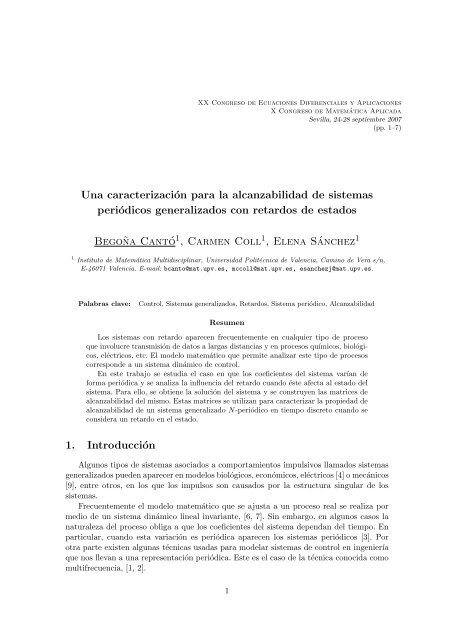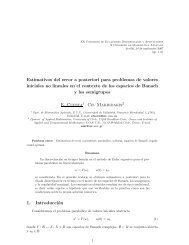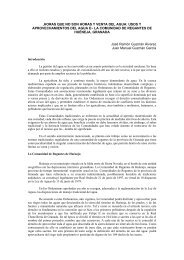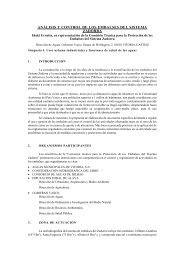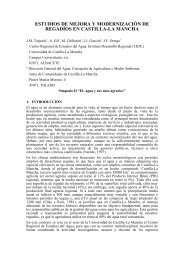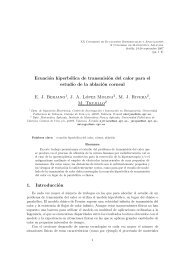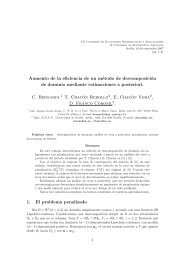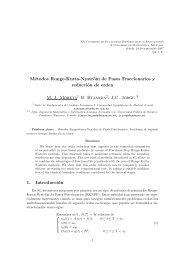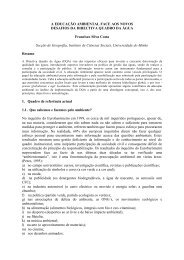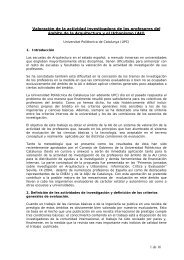Una caracterizacion para la alcanzabilidad de sistemas periodicos ...
Una caracterizacion para la alcanzabilidad de sistemas periodicos ...
Una caracterizacion para la alcanzabilidad de sistemas periodicos ...
You also want an ePaper? Increase the reach of your titles
YUMPU automatically turns print PDFs into web optimized ePapers that Google loves.
XX Congreso <strong>de</strong> Ecuaciones Diferenciales y Aplicaciones<br />
X Congreso <strong>de</strong> Matemática Aplicada<br />
Sevil<strong>la</strong>, 24-28 septiembre 2007<br />
(pp. 1–7)<br />
<strong>Una</strong> caracterización <strong>para</strong> <strong>la</strong> <strong>alcanzabilidad</strong> <strong>de</strong> <strong>sistemas</strong><br />
periódicos generalizados con retardos <strong>de</strong> estados<br />
Begoña Cantó 1 , Carmen Coll 1 , Elena Sánchez 1<br />
1 Instituto <strong>de</strong> Matemática Multidisciplinar, Universidad Politécnica <strong>de</strong> Valencia, Camino <strong>de</strong> Vera s/n,<br />
E-46071 Valencia. E-mail: bcanto@mat.upv.es, mccoll@mat.upv.es, esanchezj@mat.upv.es.<br />
Pa<strong>la</strong>bras c<strong>la</strong>ve: Control, Sistemas generalizados, Retardos, Sistema periódico, Alcanzabilidad<br />
Resumen<br />
Los <strong>sistemas</strong> con retardo aparecen frecuentemente en cualquier tipo <strong>de</strong> proceso<br />
que involucre transmisión <strong>de</strong> datos a <strong>la</strong>rgas distancias y en procesos químicos, biológicos,<br />
eléctricos, etc. El mo<strong>de</strong>lo matemático que permite analizar este tipo <strong>de</strong> procesos<br />
correspon<strong>de</strong> a un sistema dinámico <strong>de</strong> control.<br />
En este trabajo se estudia el caso en que los coeficientes <strong>de</strong>l sistema varían <strong>de</strong><br />
forma periódica y se analiza <strong>la</strong> influencia <strong>de</strong>l retardo cuando éste afecta al estado <strong>de</strong>l<br />
sistema. Para ello, se obtiene <strong>la</strong> solución <strong>de</strong>l sistema y se construyen <strong>la</strong>s matrices <strong>de</strong><br />
<strong>alcanzabilidad</strong> <strong>de</strong>l mismo. Estas matrices se utilizan <strong>para</strong> caracterizar <strong>la</strong> propiedad <strong>de</strong><br />
<strong>alcanzabilidad</strong> <strong>de</strong> un sistema generalizado N-periódico en tiempo discreto cuando se<br />
consi<strong>de</strong>ra un retardo en el estado.<br />
1. Introducción<br />
Algunos tipos <strong>de</strong> <strong>sistemas</strong> asociados a comportamientos impulsivos l<strong>la</strong>mados <strong>sistemas</strong><br />
generalizados pue<strong>de</strong>n aparecer en mo<strong>de</strong>los biológicos, económicos, eléctricos [4] o mecánicos<br />
[9], entre otros, en los que los impulsos son causados por <strong>la</strong> estructura singu<strong>la</strong>r <strong>de</strong> los<br />
<strong>sistemas</strong>.<br />
Frecuentemente el mo<strong>de</strong>lo matemático que se ajusta a un proceso real se realiza por<br />
medio <strong>de</strong> un sistema dinámico lineal invariante, [6, 7]. Sin embargo, en algunos casos <strong>la</strong><br />
naturaleza <strong>de</strong>l proceso obliga a que los coeficientes <strong>de</strong>l sistema <strong>de</strong>pendan <strong>de</strong>l tiempo. En<br />
particu<strong>la</strong>r, cuando esta variación es periódica aparecen los <strong>sistemas</strong> periódicos [3]. Por<br />
otra parte existen algunas técnicas usadas <strong>para</strong> mo<strong>de</strong><strong>la</strong>r <strong>sistemas</strong> <strong>de</strong> control en ingeniería<br />
que nos llevan a una representación periódica. Este es el caso <strong>de</strong> <strong>la</strong> técnica conocida como<br />
multifrecuencia, [1, 2].<br />
1
B. Cantó, C. Coll, E. Sánchez<br />
Desafortunadamente, el retardo temporal inherente que aparece en el comportamiento<br />
dinámico <strong>de</strong> muchos procesos físicos o <strong>de</strong> ingeniería tiene un efecto adverso sobre el<br />
comportamiento <strong>de</strong>l mo<strong>de</strong>lo. Este hecho <strong>de</strong>be tenerse en cuenta a <strong>la</strong> hora <strong>de</strong> diseñar el<br />
sistema, <strong>para</strong> que, <strong>de</strong> este modo, su comportamiento se ajuste <strong>de</strong> <strong>la</strong> forma más real posible<br />
al proceso [10].<br />
Los problemas que involucran retardos han sido estudiados en los últimos años, siendo<br />
publicados diferentes trabajos re<strong>la</strong>cionados con el tema. Por ejemplo, <strong>la</strong> resolución <strong>de</strong><br />
problemas re<strong>la</strong>tivos a <strong>la</strong> estabilidad <strong>de</strong> <strong>sistemas</strong> con retardo ha sido estudiada en [8, 11] y<br />
<strong>la</strong>s propieda<strong>de</strong>s estructurales <strong>de</strong> dichos <strong>sistemas</strong> en [5].<br />
En este trabajo se estudia <strong>la</strong> influencia que produce el retardo existente en los estados<br />
en <strong>la</strong> solución <strong>de</strong> los <strong>sistemas</strong> periódicos. En primer lugar se construye <strong>la</strong> forma explícita<br />
<strong>de</strong> <strong>la</strong> solución <strong>de</strong> este tipo <strong>de</strong> <strong>sistemas</strong>. Usando esta solución se obtienen <strong>la</strong>s matrices<br />
<strong>de</strong> <strong>alcanzabilidad</strong> y se estudia el efecto <strong>de</strong> los retardos en esta propiedad estructural.<br />
Finalmente, se caracteriza dicha propiedad en términos matriciales.<br />
2. Solución <strong>de</strong> un sistema con retardos en el estado<br />
En esta sección se obtiene <strong>la</strong> trayectoria <strong>de</strong> un sistema discreto N–periódico cuyo<br />
comportamiento varía a causa <strong>de</strong> <strong>la</strong> influencia <strong>de</strong>l retardo en los estados.<br />
Un sistema N-periódico generalizado viene dado por <strong>la</strong> siguiente ecuación en diferencias,<br />
E(k)x(k + 1) = A(k)x(k) + B(k)u(k), k ∈ Z<br />
don<strong>de</strong> E(k+N) = E(k) ∈ R n×n es una matriz singu<strong>la</strong>r, es <strong>de</strong>cir <strong>de</strong>t(E(k)) = 0, A(k+N) =<br />
A(k) ∈ R n×n , B(k + N) = B(k) ∈ R n×m y x(k) ∈ R n y u(k) ∈ R m son los vectores <strong>de</strong><br />
estado y <strong>de</strong> entrada respectivamente. Este sistema se <strong>de</strong>nota por (E(·), A(·), B(·))N.<br />
<strong>Una</strong> técnica utilizada en los <strong>sistemas</strong> N-periódicos generalizados consiste en <strong>de</strong>sacop<strong>la</strong>r<br />
el sistema en dos sub<strong>sistemas</strong> y analizarlos por se<strong>para</strong>do. Estos sub<strong>sistemas</strong> tienen <strong>la</strong><br />
siguiente estructura<br />
don<strong>de</strong><br />
x1(k + 1) = A1(k)x1(k) + B1(k)u(k),<br />
N(k)x2(k + 1) = x2(k) + B2(k)u(k), k ∈ Z<br />
E(k) = diag (In1 , N(k)) , A(k) = diag (A1(k),<br />
<br />
B1(k)<br />
In2 ) , B(k) =<br />
B2(k)<br />
siendo N(k) una matriz nilpotente y n2 = n − n1. El subsistema progresivo se <strong>de</strong>nota por<br />
(In1 , A1(·), B1(·)) y el subsistema regresivo por (N(·), In2 , B2(·)).<br />
En <strong>la</strong> solución <strong>de</strong> este tipo <strong>de</strong> <strong>sistemas</strong> están involucradas <strong>la</strong>s matrices <strong>de</strong> transición<br />
<strong>de</strong> estados. La matriz <strong>de</strong> transición <strong>de</strong> estados asociada al subsistema progresivo viene<br />
<strong>de</strong>finida por<br />
φA1 (k, k0) = A1(k − 1)A1(k − 2) · · · A1(0), k > k0, φA1 (k0, k0) = I<br />
2<br />
<br />
,
Alcanzabilidad <strong>sistemas</strong> periódicos con retardos<br />
y <strong>la</strong> matriz <strong>de</strong> transición <strong>de</strong> estados asociada al subsistema regresivo viene <strong>de</strong>finida por<br />
ψN(k, k0) = N(k)N(k + 1) · · · N(k0 − 1), k < k0, ψN(k0, k0) = I.<br />
En concreto <strong>para</strong> s = 0, 1, . . . , N − 1, <strong>la</strong>s matrices A1,s = φA1 (s + N, s) y Ns =<br />
ψN(s, s + N) se <strong>de</strong>nominan matriz <strong>de</strong> monodromía progresiva y matriz <strong>de</strong> monodromía<br />
regresiva, respectivamente.<br />
La solución <strong>de</strong> un sistema N-periódico progresivo-regresivo viene <strong>de</strong>terminada por <strong>la</strong>s<br />
siguientes expresiones,<br />
y<br />
x1(k) = φA1 (k, s)x1(s)<br />
k−1<br />
+ φA1 (k, j + 1)B1(j)u(j)<br />
j=s<br />
k+qN−1 <br />
x2(k) = − ψN(k, j)B2(j)u(j), k ≥ s, (1)<br />
j=k<br />
don<strong>de</strong> q = max{ind(Ns), s = 0, 1, . . . , N − 1}, siendo ind(Ns) el índice <strong>de</strong> nilpotencia <strong>de</strong><br />
Ns.<br />
Ahora se consi<strong>de</strong>ra el sistema N-periódico generalizado con un retardo en el estado<br />
dado por <strong>la</strong> siguiente ecuación en diferencias,<br />
E(k)x(k + 1) = A1(k)x(k) + Ad(k)x(k − 1) + B(k)u(k), k ∈ Z<br />
don<strong>de</strong> Ad(k + N) = Ad(k) ∈ Rn×n , representa el retardo. Este sistema se <strong>de</strong>nota por<br />
(E(·), A1(·), Ad(·), B(·))N.<br />
Si Ad(k) = diag (Ad1(k), On2 ) y se aplica a este sistema <strong>la</strong> misma técnica que en el<br />
caso sin retardos vista anteriormente, se obtienen <strong>la</strong>s siguientes ecuaciones,<br />
x1(k + 1) = A11(k)x1(k) + Ad1(k)x1(k − 1) + B1(k)u(k), (2)<br />
N(k)x2(k + 1) = x2(k) + B2(k)u(k), k ∈ Z. (3)<br />
En este caso, el subsistema progresivo (2) se <strong>de</strong>nota por (In1 , A11(·), Ad1(·), B1(·)) N y el<br />
subsistema regresivo (3) por (N(·), In2 , B2(·)) N .<br />
Antes <strong>de</strong> obtener <strong>la</strong> solución <strong>de</strong>l subsistema progresivo (2), se <strong>de</strong>finen <strong>la</strong>s siguientes<br />
matrices N–periódicas.<br />
En <strong>la</strong> notación utilizada a continuación, s seña<strong>la</strong> el instante inicial, k indica el número<br />
<strong>de</strong> pasos, mientras que j es un contador. Para s = 0, 1, . . . , N −1, k ≥ 0 y j = 0, 1, . . . , k−1,<br />
(s) vienen dadas por <strong>la</strong>s siguientes expresiones,<br />
<strong>la</strong>s matrices S j<br />
k<br />
S j<br />
j (s) = 0,<br />
j = k − 1, S j<br />
k (s) = B1(s + j),<br />
j = 0, 1, . . . , k − 2, S j<br />
k (s) = A11(s + k − 1)S j<br />
k−1 (s) + Ad1(s + k − 1)S j<br />
k−2 (s).<br />
Para s = 0, 1, . . . , N − 1, k ≥ 0 y j = 0, 1, <strong>la</strong>s matrices G j<br />
k (s), se <strong>de</strong>finen como<br />
k = 0, G0 0 (s) = I y G10 (s) = 0,<br />
3
B. Cantó, C. Coll, E. Sánchez<br />
k = 1, G0 1 (s) = A11(s) y G1 1 (s) = Ad1(s),<br />
k ≥ 2, j = 0, 1, G j<br />
k (s) = A11(s + k − 1)G j<br />
k−1 (s) + Ad1(s + k − 1)G j<br />
k−2 (s).<br />
Sin pérdida <strong>de</strong> generalidad se consi<strong>de</strong>ra s = 0. Usando <strong>la</strong>s matrices S j<br />
k (0), j =<br />
0, 1, . . . , k − 1 y G0 k (0), G1 k (0), k ≥ 0, se obtiene <strong>la</strong> solución explícita <strong>de</strong>l subsistema progresivo<br />
dado en el siguiente resultado.<br />
Teorema. Se consi<strong>de</strong>ra el subsistema N–periódico progresivo con retardo en el estado<br />
(In1 , A11(·), Ad1(·), B1(·)) N , dado en (2). La solución <strong>de</strong>l sistema viene dada por<br />
siendo Sk(0) = [S 0 k (0), S1 k<br />
x1(k) = G 0 k (0)x1(0) + G 1 k (0)x1(−1) + Sk(0)<br />
(0), . . . , Sk−1<br />
k (0)].<br />
⎡<br />
⎢<br />
⎣<br />
u(0)<br />
.<br />
u(k − 1)<br />
⎤<br />
⎥<br />
⎦ (4)<br />
Demostración. Para k = k − 1, se reemp<strong>la</strong>za <strong>la</strong> solución (4) en el sistema (2),<br />
x1(k) = A11(k − 1)x1(k − 1) + Ad1(k − 1)x1(k − 2) + B1(k − 1)u(k − 1)<br />
= A11(k − 1)(G 0 k−1 (0)x1(0) + G 1 k−1 (0)x1(−1) + Sk−1(0)[u(0) ′ , . . . , u(k − 2) ′ ] ′ )<br />
+A11(k − 1)(G 0 k−2 (0)x1(0) + G 1 k−2 (0)x1(−1) + Sk−2(0)[u(0) ′ , . . . , u(k − 3) ′ ] ′ )<br />
+B1(k − 1)u(k − 1),<br />
don<strong>de</strong> M ′ <strong>de</strong>nota <strong>la</strong> matriz transpuesta <strong>de</strong> M. Como,<br />
y<br />
se tiene que<br />
(A11(k − 1)G 0 k−1 (0) + Ad1(k − 1)G 0 k−2 (0))x1(0) = G 0 k (0)x1(0),<br />
(A11(k − 1)G 1 k−1 (0) + Ad1(k − 1)G 1 k−2 (0))x1(−1) = G 1 k (0)x1(−1)<br />
A11(k − 1)Sk−1(0)[u(0) ′ , . . . , u(k − 2) ′ ] ′ + Ad1(k − 1)Sk−2(0)[u(0) ′ , . . . , u(k − 3) ′ ] ′<br />
+B1(k − 1)u(k − 1) =<br />
= (A11(k − 1)S 0 k−1 (0) + Ad1(k − 1)S 0 k−2 (0))u(0)<br />
+(A11(k − 1)S 1 k−1 (0) + Ad1(k − 1)S 1 k−2 (0))u(1) + . . .<br />
+(A11(k − 1)S k−3<br />
k−1 (0) + Ad1(k − 1)S k−3<br />
k−2 (0))u(k − 3)<br />
+(A11(k − 1)S k−2<br />
k−1 (0)]u(k − 2), B1(k − 1)u(k − 1),<br />
x1(k) = G 0 k (0)x1(0) + G 1 k (0)x1(−1) + Sk(0)[u(0) ′ , . . . , u(k − 1) ′ ] ′ ,<br />
siendo Sk(0) = [S0 k (0), S1 k (0), . . . , Sk−1<br />
k (0)]. <br />
Por otra parte, <strong>la</strong> solución <strong>de</strong>l subsistema regresivo (3) viene <strong>de</strong>finida por (1).<br />
4
Alcanzabilidad <strong>sistemas</strong> periódicos con retardos<br />
3. Alcanzabilidad <strong>de</strong> un sistema con retardo en el estado<br />
En esta sección se estudia <strong>la</strong> propiedad <strong>de</strong> <strong>alcanzabilidad</strong> <strong>para</strong> un sistema discreto<br />
N–periódico con retardo en el estado. Para ello se necesita <strong>la</strong> matriz <strong>de</strong> <strong>alcanzabilidad</strong> que<br />
se construye a partir <strong>de</strong> <strong>la</strong> solución <strong>de</strong>l sistema.<br />
Un sistema es alcanzable, si existe una sucesión <strong>de</strong> controles que conduce dicho sistema<br />
<strong>de</strong>s<strong>de</strong> el origen hasta el estado final.<br />
Para el susbsistema progresivo, <strong>la</strong> matriz <strong>de</strong> <strong>alcanzabilidad</strong> viene <strong>de</strong>finida por,<br />
R f<br />
kN (In1 , A11(·),<br />
<br />
Ad1(·), B1(·), s) = SkN(s) = fil S j<br />
kN (s)<br />
kN−1<br />
y <strong>para</strong> el subsistema regresivo, <strong>la</strong> matriz <strong>de</strong> <strong>alcanzabilidad</strong> viene <strong>de</strong>finida por,<br />
j=0<br />
, k ∈ Z (5)<br />
R b (N(·), In2 , B2(·), s) = fil [ψN(s, s + j − 1)B2(s + j − 1)] qN<br />
j=1 , (6)<br />
q = max{ind(Ns), s = 0, 1, . . . , N − 1}. Nótese que un estado alcanzable x en el tiempo s<br />
en k pasos es dado por <strong>la</strong> sucesión <strong>de</strong> controles u(s), u(s + 1), . . . , u(k + qN − 1) y por <strong>la</strong>s<br />
matrices (5-6).<br />
Se <strong>de</strong>fine <strong>la</strong> matriz <strong>de</strong> <strong>alcanzabilidad</strong> en el instante s, s = 0, 1, . . . , N − 1, en nN pasos<br />
<strong>de</strong>l sistema progresivo-regresivo (2-3), como una matriz diagonal por bloques dada por<br />
RnN(E(·), A1(·), Ad(·), B(·), s) =<br />
diag[R f<br />
n1N (In1 , A11(·), Ad1(·), B1(·), s), R b (N(·), In2 , B2(·), s)].<br />
En el siguiente resultado, se consigue una caracterización sobre <strong>la</strong> propiedad <strong>de</strong> <strong>alcanzabilidad</strong>.<br />
Teorema. Se consi<strong>de</strong>ra el sistema N–periódico con retardo en el estado (E(·), A1(·),<br />
Ad(·), B(·))N, dado en (2-3). El sistema es alcanzable en el tiempo s, s = 0, 1, . . . , N − 1<br />
si, y só<strong>la</strong>mente si<br />
rg (RnN(E(·), A1(·), Ad(·), B(·), s)) = n.<br />
En el siguiente ejemplo se comprueba el resultado dado en el teorema anterior <strong>para</strong> un<br />
sistema discreto 2–periódico con retardo en el estado.<br />
Ejemplo. Sea (E(·), A1(·), Ad(·), B(·))2 un sistema discreto 2–periódico con retardo<br />
en el estado dado por<br />
5
E(0) = E(1) =<br />
A1(1) =<br />
Ad(1) =<br />
⎡<br />
⎢<br />
⎣<br />
⎡<br />
⎢<br />
⎣<br />
⎡<br />
⎢<br />
⎣<br />
B. Cantó, C. Coll, E. Sánchez<br />
1 0 0 0<br />
0 1 0 0<br />
0 0 0 1<br />
0 0 0 0<br />
2 0 0 0<br />
0 4 0 0<br />
0 0 1 0<br />
0 0 0 1<br />
0 0 0 0<br />
0 1 0 0<br />
0 0 0 0<br />
0 0 0 0<br />
⎤<br />
⎥<br />
⎦<br />
⎤<br />
⎥<br />
⎦<br />
⎤<br />
⎥<br />
⎦ A1(0) =<br />
Ad(0) =<br />
⎡<br />
⎢<br />
⎣<br />
⎡<br />
⎢<br />
⎣<br />
B(0) =<br />
1 2 0 0<br />
1 0 0 0<br />
0 0 1 0<br />
0 0 0 1<br />
2 1 0 0<br />
0 0 0 0<br />
0 0 0 0<br />
0 0 0 0<br />
⎡<br />
⎢<br />
⎣<br />
−1<br />
0<br />
0<br />
1<br />
⎤<br />
⎥<br />
⎦<br />
⎤<br />
⎥<br />
⎦<br />
⎤<br />
⎥<br />
⎦<br />
B(1) =<br />
Se consi<strong>de</strong>ran <strong>la</strong>s matrices <strong>de</strong> <strong>alcanzabilidad</strong> <strong>para</strong> cada subsistema, siendo s = 0, 1. Para<br />
s = 0 se obtiene,<br />
R f<br />
4 (I2, A11(·), Ad1(·), B1(·), 0) = S 0 4(0) S 1 4(0) S 2 4(0) S 3 4(0) <br />
= [(A11(1)A11(0)A11(1) + A11(1)Ad1(0) + Ad1(1)A11(1))B1(0),<br />
=<br />
Por otra parte, como q = 1,<br />
Por tanto,<br />
(A11(1)A11(0) + Ad1(1))B1(1), A11(1)B1(0), B1(1)]<br />
<br />
−8 10 −2 3<br />
−8 13 0 1<br />
R b (N(·), I2, B2(·), 0) = [ψN(0, 0)B2(0), ψN(0, 1)B2(1)] =<br />
Para s = 1 se obtiene,<br />
y<br />
Por tanto,<br />
rg (R8(E(·), A1(·), Ad(·), B(·), 0)) = 4 = n.<br />
0 1<br />
1 0<br />
R f<br />
4 (I2, A11(·), Ad1(·), B1(·), 1) = S 0 4(1) S 1 4(1) S 2 4(1) S 3 4(1) <br />
= [(A11(1)A11(0)A11(1) + A11(1)Ad1(0) + Ad1(1)A11(1))B1(1),<br />
=<br />
(A11(1)A11(0) + Ad1(1))B1(0), A11(1)B1(1), B1(0)]<br />
<br />
42 −2 6 −1<br />
28 −4 4 0<br />
R b (N(·), I2, B2(·), 1) = [ψN(1, 1)B2(1), ψN(1, 2)B2(0)] =<br />
rg (R8(E(·), A1(·), Ad(·), B(·), 1)) = 4 = n.<br />
−2 1<br />
1 0<br />
Y por el teorema anterior se concluye que el sistema es alcanzable <strong>para</strong> s = 0, 1.<br />
6<br />
⎡<br />
⎢<br />
⎣<br />
<br />
.<br />
<br />
.<br />
3<br />
1<br />
−2<br />
1<br />
⎤<br />
⎥<br />
⎦
Agra<strong>de</strong>cimientos<br />
Alcanzabilidad <strong>sistemas</strong> periódicos con retardos<br />
Trabajo financiado por <strong>la</strong>s ayudas españo<strong>la</strong>s AGL2004-03262/AGR y GV06/118 y por<br />
el programa <strong>de</strong> investigación <strong>de</strong> <strong>la</strong> UPV.<br />
Referencias<br />
[1] P. Albertos, Block multirate input–output mo<strong>de</strong>l for sampled data control systems. IEE Trans. Aut.<br />
Control, 35(9), (1990), 1085–1088.<br />
[2] M. Bidani, M. Djemai, A multirate digital control via a discrete–time observer for non–linear singu<strong>la</strong>rly<br />
perturber continuous–time systems, International Journal of Control, 75(8), (2002), 591-613.<br />
[3] R. Bru, R. Cantó, B. Ricarte, Mo<strong>de</strong>lling nitrogen dynamics in citrus trees, Mathematical and Computer<br />
Mo<strong>de</strong>lling, 38/10, (2003), 975-987.<br />
[4] S.L. Singu<strong>la</strong>r Systems of differential Equations, Pitman Books Ltd., London, 1980.<br />
[5] V.Y. Glicer, Eucli<strong>de</strong>an space control<strong>la</strong>bility of singu<strong>la</strong>rly perturber linear systems with state <strong>de</strong><strong>la</strong>y,<br />
System and Control Letters, 43, (2001), 181-191.<br />
[6] J.A. Jacquez, C.P. Simon, Quantitative theory of compartmental systems, SIAM Review, 35(1),<br />
(1993), 43-79.<br />
[7] D.G. Luenberger, Introduction to dynamic systems, Vol. I, John Wiley & Sons, Inc., New York, 1979.<br />
[8] M.S. Mahmoud, Robust H∞ control of discrete systems with uncertain <strong>para</strong>meters and unknown<br />
<strong>de</strong><strong>la</strong>ys, Automatica, 36, (2000), 627-635.<br />
[9] P.C. Müller, Linear mechanical <strong>de</strong>scriptor systems: i<strong>de</strong>ntification, analysis and <strong>de</strong>sign, Preprints of<br />
IFAC, Belfort, (1997), 501-506.<br />
[10] S.L. Niculescu De<strong>la</strong>y effects on stability. A robust control approach, 269, Springer-Ver<strong>la</strong>g, Hei<strong>de</strong>lberg,<br />
LNCIS, 2001.<br />
[11] S.L. Niculescu and R. Lozano, On passivity of linear <strong>de</strong><strong>la</strong>y systems, IEE Transactions on Automatic<br />
Control, 46(3), (2001), 460-464.<br />
7


